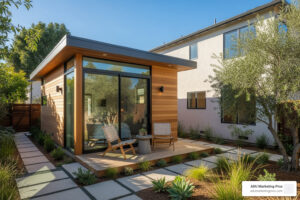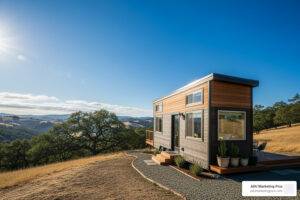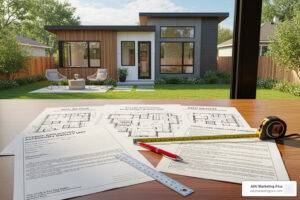Why Los Angeles Homeowners Are Turning to Affordable ADUs
Affordable adu los angeles options are changing how families address housing challenges in one of America’s most expensive cities. As home prices and rental costs climb, accessory dwelling units (ADUs) offer a practical way to add living space or generate rental income.
Quick Answer: Affordable ADU Options in LA
- Prefab ADUs: $184,000-$450,000 (400-1,200 sq ft)
- Stick-built ADUs: $150,000-$300,000+
- Permits: $1,000-$3,000
- Site prep: $5,000-$15,000
- Timeline: 5-8 months total
- Financing: Home equity loans, grants up to $40,000
Los Angeles faces a significant housing crisis. The city’s 500,000 single-family homes represent untapped potential; if just 10% added an ADU, housing density could increase substantially in a few years.
ADUs, also known as granny flats or backyard homes, provide flexible solutions for modern families. They can serve as a home for an aging parent, a dedicated office, or a rental unit to help with the mortgage. New California laws have made ADUs easier and more affordable to build than ever by reducing setback requirements, streamlining permitting, and waiving some parking rules.
This guide breaks down everything you need to know about building an affordable ADU in Los Angeles, from understanding your options to navigating permits and financing.
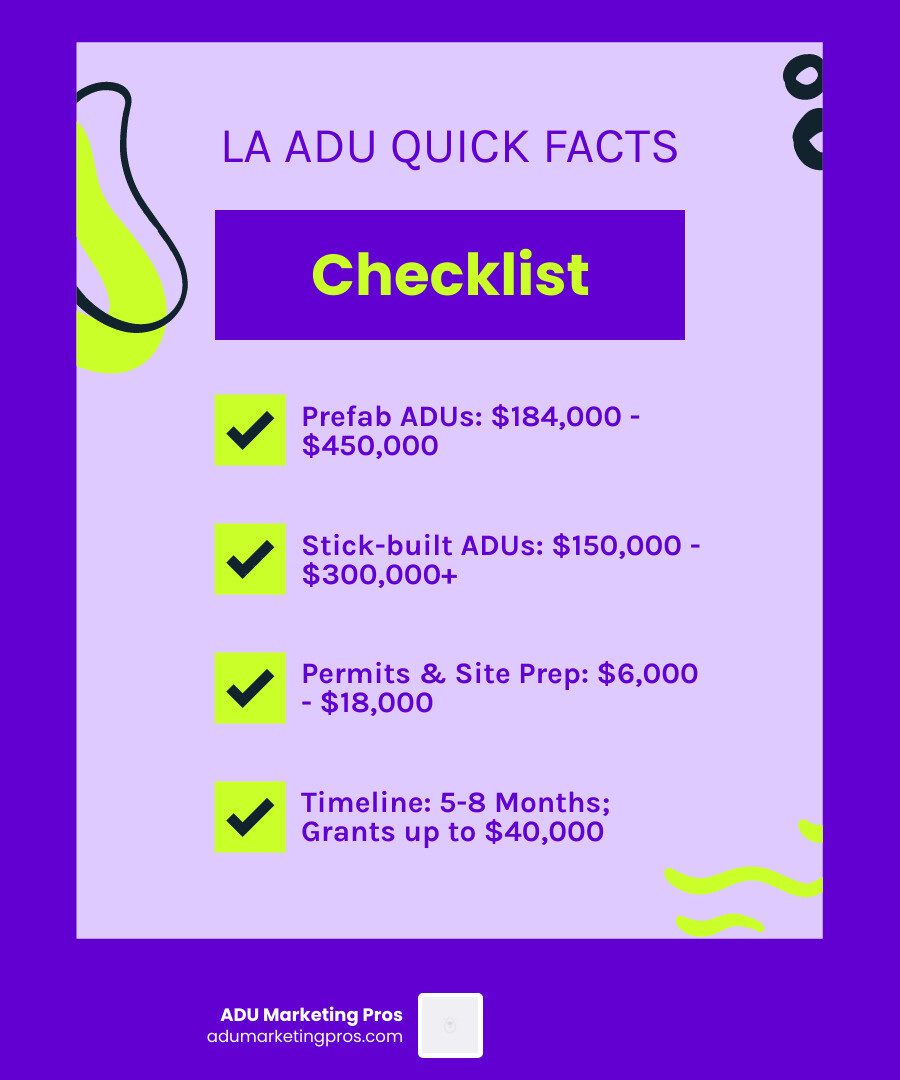
Affordable adu los angeles further reading:
What is an ADU and Why Build One in Los Angeles?
An Accessory Dwelling Unit (ADU) is a second, smaller home that shares a property with a single-family house. These self-contained units include their own kitchen, bathroom, and sleeping area, often with a separate entrance. They can be a stand-alone structure, an extension of the main home, or a conversion of an existing space like a garage. For more details, you can review official resources from the City of Los Angeles. More info about ADUs.
Homeowners across Los Angeles are choosing to build an affordable adu los angeles for numerous benefits:
- Increased Property Value: Adding an ADU boosts your home’s worth and creates an asset that appreciates over time.
- Passive Rental Income: In LA’s busy rental market, an ADU can provide a steady income stream to offset mortgage payments or build savings.
- Multi-Generational Living: ADUs are an ideal solution for housing aging parents or adult children, allowing them to live close by while maintaining their independence.
- Flexible Space: An ADU can serve as a home office, creative studio, or guest suite, adapting to your family’s changing needs.
- Addressing the Housing Shortage: By adding density to existing residential lots, ADUs help create more housing options without altering neighborhood character.

Different Types of ADUs
There are several ADU formats to consider, each with unique advantages:
- Detached New Construction: A standalone backyard structure offering maximum design freedom and privacy.
- Attached ADU: An addition connected to your main home, suitable for properties with limited yard space.
- Junior Accessory Dwelling Unit (JADU): A unit of no more than 500 square feet created within the existing home’s footprint. It must have an efficiency kitchen and can share a bathroom with the main house, making it a cost-effective option.
- Garage Conversion: A popular and budget-friendly choice that transforms an existing garage into a living space.
- Above-Garage ADU: A new unit built above an existing garage, providing privacy and potentially better views.
For layout ideas, explore our resources on ADU Building Plans Los Angeles.
How ADUs Contribute to Affordable Housing
ADUs are a powerful, grassroots solution to the housing affordability crisis in Los Angeles. By increasing housing density on existing lots, they add needed housing units without requiring massive new developments. Several innovative programs leverage ADUs to create more affordable housing opportunities:
- The Backyard Homes Project: This initiative helps homeowners build an ADU in exchange for renting the unit affordably to a Section 8 voucher holder for at least five years. The program offers support with financing, design, permitting, and construction.
- LA ADU Accelerator Program: This program pairs older adults who need stable housing with homeowners willing to rent their ADUs. It provides homeowners with qualified tenant referrals, case management, and secure, long-term tenancy. It’s a win-win that provides homeowners with reliable tenants and older Angelenos with safe, affordable housing. More on the LA ADU Accelerator Program.
These programs show that ADUs are not just a smart private investment but also a vital part of LA’s strategy for a more equitable housing landscape.
The Real Cost of an Affordable ADU in Los Angeles
When planning for an affordable adu los angeles, understanding the real costs upfront is crucial. The total cost depends on several key factors, including the unit’s size, your choice of materials and finishes, and the construction method (stick-built vs. prefabricated).
Site conditions also play a significant role. A flat, accessible lot is ideal, whereas a sloped property or complex soil conditions can increase costs. The distance and complexity of utility connections for water, sewer, and electricity will also impact the final price.
For a detailed look at expenses, see our guide on Los Angeles ADU Cost. You can also get a personalized estimate with our ADU Cost Calculator.
Breakdown of Average ADU Costs
Here is a breakdown of where your money goes when building an ADU:
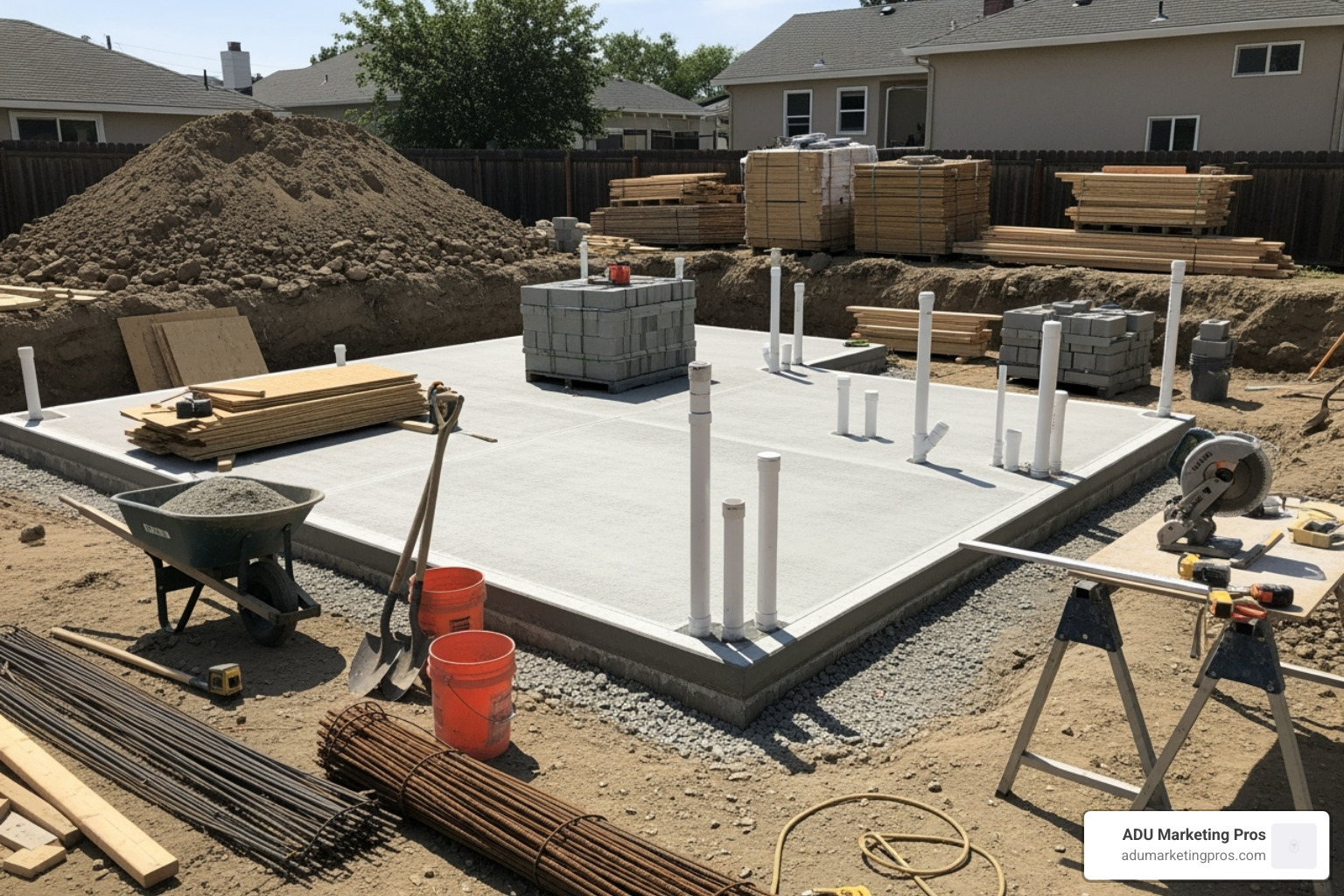
- Permit Fees: Typically $1,000 to $3,000 in Los Angeles, these fees cover the city’s review and approval of your plans to ensure they meet safety and zoning codes.
- Design and Planning: Usually ranging from $20,000 to $30,000, this includes architectural drawings, engineering plans, and required surveys. A good architect helps maximize space while staying within budget.
- Site Preparation: Basic site prep costs $5,000 to $15,000 and covers clearing, grading, foundation work, and utility trenching. Challenging lots with steep slopes or poor soil can increase these costs.
- Construction Expenses: This is the largest part of the budget. Stick-built units cost $150,000 to $300,000+. Prefab units may cost $50,000 to $150,000 for the structure alone, with premium models reaching $450,000 fully installed.
- Utility Connections: Hooking up electrical, plumbing, and HVAC systems typically runs $3,400 to $10,400, depending on the complexity.
- Contingency: It’s wise to budget an extra 10-15% for unexpected costs like landscaping, fencing, or surprises during construction.
Be aware that some prefab companies quote low base prices but add significant fees for permits, planning, and installation. Always request a complete, all-inclusive quote.
Finding an affordable ADU in Los Angeles: Prefab vs. Custom
Choosing between a prefab or custom-built ADU is a key decision. Both can be great options, but they offer different advantages.
Prefab ADUs are built in a factory and installed on your property. This method offers faster construction and potentially lower costs, with total project costs typically running $184,000 to $450,000. The factory construction takes 3-6 months, while site prep happens simultaneously, leading to a total project timeline of 6-12 months. However, customization is limited to pre-designed models and finishes.
Custom-built ADUs are designed specifically for your property and built on-site. Costs generally range from $150,000 to $300,000+, with a longer timeline of 8-18 months. This approach offers complete design flexibility, allowing you to match your home’s architecture or accommodate unique lot features. However, it involves more on-site disruption.
The choice depends on your priorities: speed and simplicity (prefab) versus customization and flexibility (custom). Both can result in an affordable ADU that adds value to your property. For more on managing expenses, see our guide on ADU Building Costs.
Navigating LA’s ADU Regulations, Permits, and Financing
Building an ADU in Los Angeles requires navigating city and state regulations. The City of Los Angeles ADU Ordinance (Ord. 186,481) and state laws have significantly streamlined the process, but compliance is essential for a smooth project.
For a comprehensive overview, see Your Guide to Los Angeles ADU Regulations: What You Need to Know.
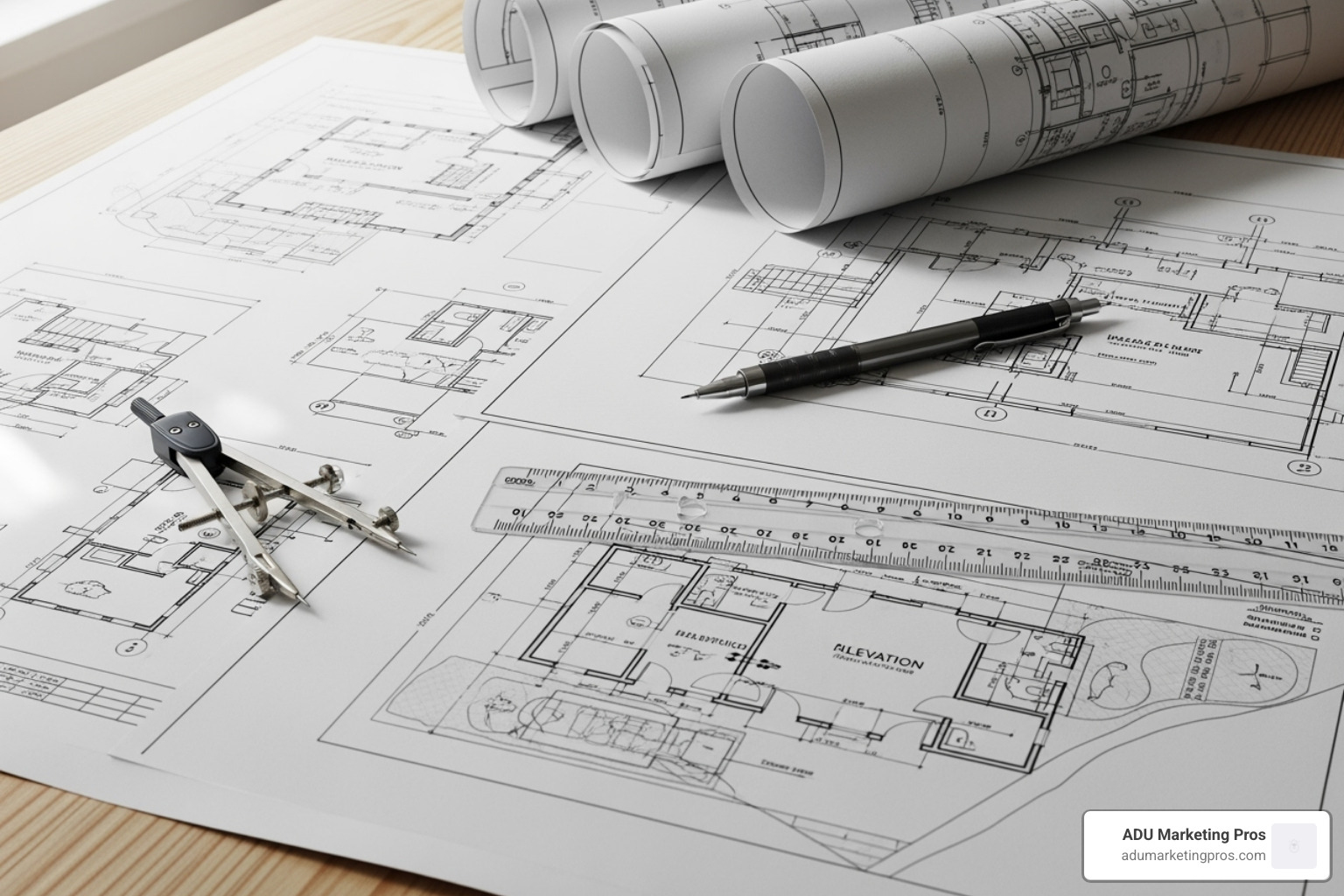
Key Steps for Obtaining ADU Permits
The permitting process follows a structured path:
- Zoning Check: Confirm your property’s eligibility and specific requirements using the city’s ZIMAS (Zone Information and Map Access System) portal.
- Plan Submission: Submit your plans to the Los Angeles Department of Building and Safety (LADBS), often electronically via the ePlanLA system.
- LADBS Review: LADBS reviews plans for code compliance. State law mandates a 60-day review period for ADU applications.
- Clearances: Obtain necessary clearances from other departments like DWP, the Fire Department, or Public Works.
- Inspections: City inspectors visit at key construction stages to ensure work matches the approved plans.
- Certificate of Occupancy (C of O): After the final inspection, you’ll receive a C of O, officially deeming the unit ready for use.
ADU permit costs in Los Angeles typically range from $1,000 to $3,000. For more details, see our resource on ADU Permit Cost California.
Zoning and Building Code Essentials
Key requirements for a compliant ADU project include:
- Setbacks: New laws allow minimal setbacks, typically 4 feet from the side and rear property lines for detached ADUs.
- Height Limits: Detached ADUs generally have a maximum height of 16 feet.
- Maximum Size: ADUs can be up to 1,200 square feet.
- Parking Requirements: Parking is not required for a new ADU if it’s within a half-mile walk of public transit or if a garage is demolished to build the ADU.
- Solar Panel Mandate: Newly constructed, detached ADUs require solar panels.
- Fire Sprinklers: Sprinklers are only required for the ADU if they are also required for the primary home.
The LADBS website is the best source for up-to-date information. LADBS ADU requirements.
How to Finance an affordable ADU in Los Angeles
Understanding your financing options is key to building an affordable adu los angeles. Common methods include:
- Home Equity Loans/Lines of Credit (HELOCs): Use the equity in your primary home to fund the project.
- Construction Loans: These specialized loans disburse funds in stages as work progresses.
- Cash-out Refinancing: Refinance your existing mortgage for a larger amount and use the cash difference for your ADU.
- Government Grants: The CalHFA ADU Grant Program offers up to $40,000 for pre-development costs like design, permits, and site prep. While funding rounds can be limited, it’s worth checking for current availability as these programs are often renewed. CalHFA ADU Grant Program.
For a deeper dive, visit our guides on ADU Financing Options and ADU Funding Grants.
Maximizing Your Return: Rental Income and Support Programs
One of the most compelling reasons to build an affordable adu los angeles is the potential for a significant return on investment (ROI). The strong Los Angeles rental market creates high demand for housing, making a new ADU a desirable rental unit.
The monthly income from an ADU can help offset your primary mortgage payments or create a new income stream for savings and investments. Beyond monthly rent, an ADU also increases your property’s appraisal value. Homes with rental units are often attractive to future buyers, potentially leading to faster appreciation over time.
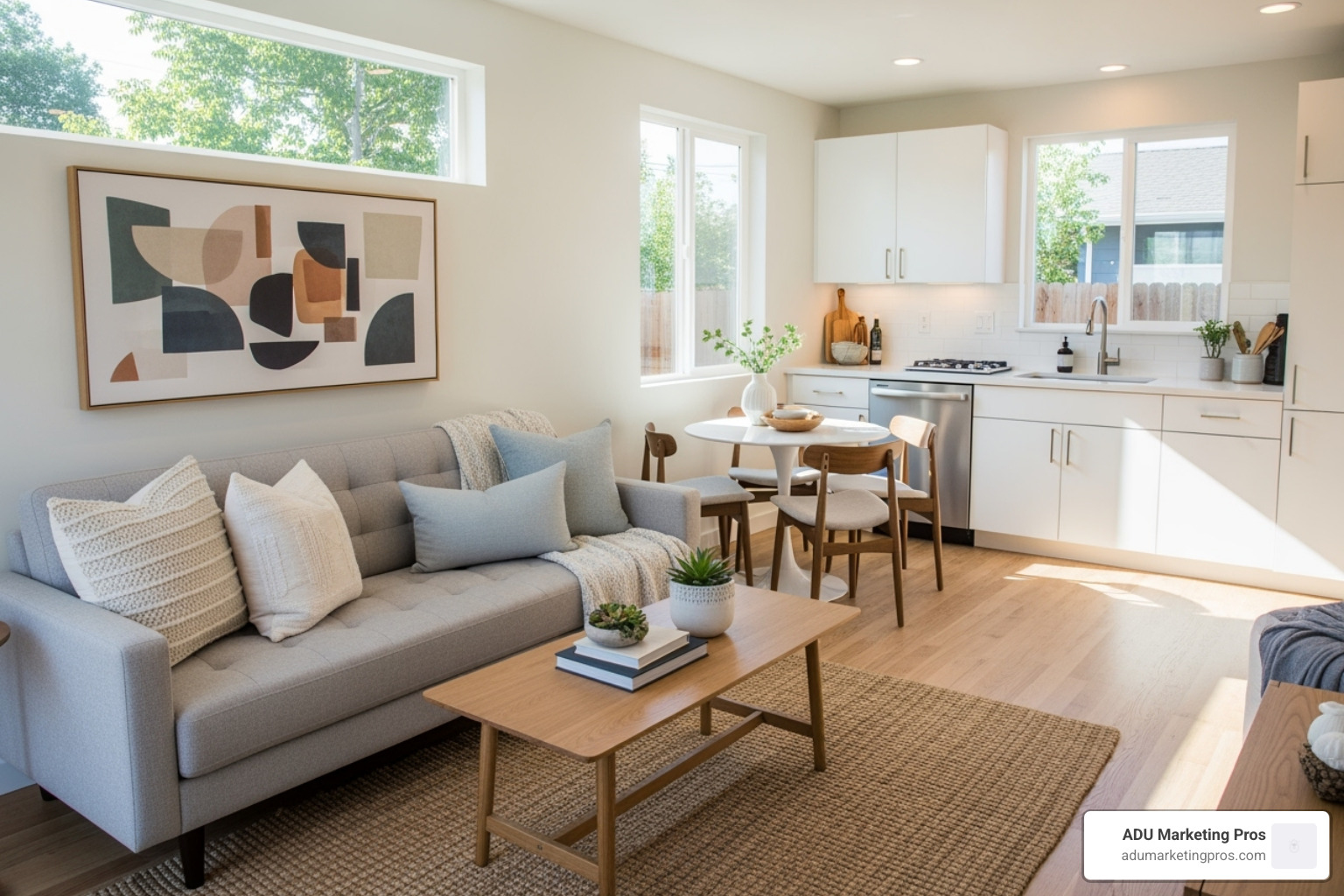
Support Services for Homeowners
The City of Los Angeles and various non-profits offer support to homeowners building or renting out ADUs, recognizing their value to the community.
- The LA ADU Accelerator Program connects homeowners with older adults seeking stable housing. The program offers homeowners benefits like qualified tenant referrals, case management, and stable rental income, often with a five-year commitment.
- The Backyard Homes Project helps homeowners in Northeast Los Angeles build an ADU in exchange for renting it affordably to a Section 8 voucher holder for at least five years. This “one-stop shop” guides homeowners through design, financing, permitting, and construction.
These programs simplify the ADU development process and ensure that new units contribute to the city’s affordable housing supply. When choosing a partner for your project, look for experienced professionals. For a list of reputable builders, see our guide on ADU Builder Los Angeles.
Frequently Asked Questions about Affordable ADUs in LA
Here are answers to some of the most common questions about building an affordable adu los angeles.
How long does it take to build an ADU in Los Angeles?
The total project time varies by ADU type. The process includes a design phase, a permitting timeline, and the construction duration.
- Permitting: California law mandates that local agencies review ADU plans within 60 days of submission, which helps keep projects on track.
- Construction: A traditional stick-built ADU typically takes 2 to 3 months to build on-site. A prefab ADU is manufactured in a factory in 3 to 6 months, with on-site installation taking only days or weeks.
- Total Timeline: From contract to completion, a prefab ADU project usually takes 5 to 8 months. A custom stick-built ADU can take 8 to 18 months, depending on design complexity.
Can I build an ADU on my property if I have a small lot?
Yes. Recent California laws have removed minimum lot size requirements for ADUs, making it possible to build on smaller properties. The key is working within the setback rules, which are now very favorable, typically requiring just 4 feet from the side and rear property lines for detached ADUs.
Creative design is essential for maximizing functionality in a compact footprint. Experienced architects can use smart storage, vertical space, and natural light to make smaller units feel spacious. Many pre-approved plans are specifically designed for efficient use of space. To see what’s possible, explore options for Pre-Approved ADU Plans Los Angeles.
Do I have to pay property taxes on my ADU?
Yes, adding an ADU will likely trigger a reassessment of your property’s value and increase your annual property taxes. However, this is not a complete reassessment of your entire property. Instead, the tax increase is a blended assessment that applies only to the added value of the ADU itself. This new value is added to your existing property tax base.
While this means a higher tax bill, the significant increase in property value and the potential for rental income often far outweigh this additional cost. We recommend consulting a tax professional for personalized advice on your financial situation.
Conclusion
Building an affordable adu los angeles is a practical and intelligent solution for homeowners facing housing challenges. These versatile backyard homes offer flexibility for families, whether as a space for aging parents, a private home office, or a source of significant rental income. An ADU not only addresses personal housing needs but also contributes to the broader needs of the community.
Creating an affordable ADU is more achievable than ever, thanks to streamlined regulations, diverse financing options, and supportive city programs. While an ADU project requires careful planning and investment, the long-term benefits—including increased property value, financial stability, and improved living space—are substantial.
For ADU construction and architecture firms working to attract clients in this booming market, partnering with a specialized marketing agency is key. At ADU Marketing Pros, we understand the unique challenges of your industry. We help firms showcase their expertise and stand out from the competition. To learn how we can help your business thrive, explore our insights on ADU architect marketing.


